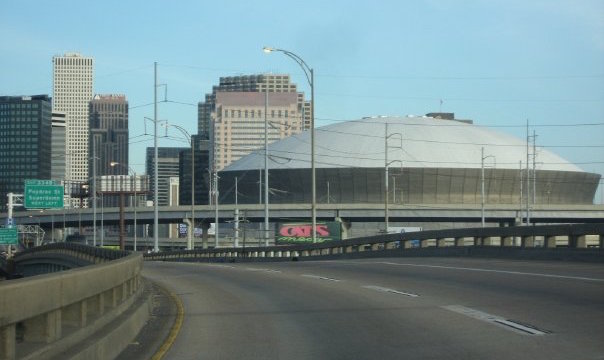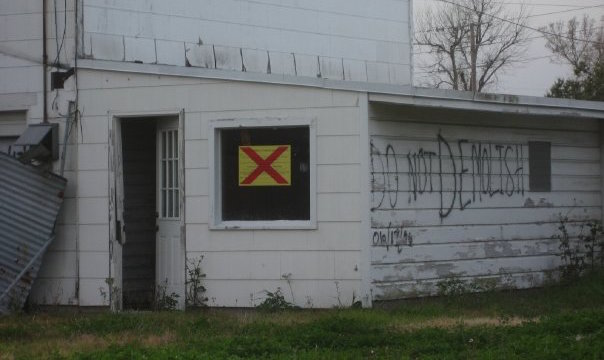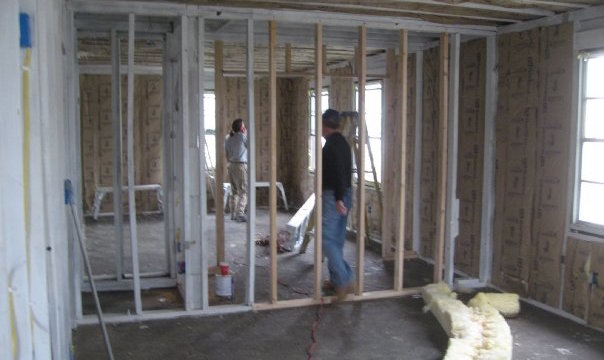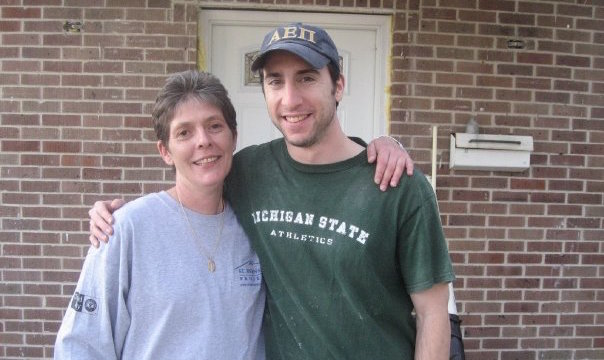Ten years ago, Hurricane Katrina rocked the Gulf Coast and became one of the most startling, devastating stories of the decade.
When it happened, I was unemployed … and ready to book a flight to New Orleans.
I wanted to do whatever I could to help, but two factors kept me away. The Red Cross had requested only volunteers with medical training, which would have left me useless. Also, shortly around the time when I would have bought my ticket, I received and accepted a job offer to work in Buffalo, NY and needed to turn most of my attention to that.
But I kept New Orleans on my mind. Three years later, I booked a flight to go down for a week and help rebuild a home … but then cancelled the flight when a different hurricane, Gustav, placed the region on alert.
Finally, in the winter of 2009 — a perfect time to vacate Buffalo for warmer temperatures — I succeeded. I re-booked flights and signed up to volunteer with the St. Bernard Project, which still does tremendous work with residents displaced from their homes. With nothing to stop me, I headed down South.
And I will never forget what followed.
My week in New Orleans filled me with emotions: anger and admiration, frustration and inspiration, horror and humility. I twice almost cried — once out of extreme sadness, once out of immense joy. But I knew I wanted to document these feelings, and not just with my camera.
So I wrote. I used the now-forgotten Facebook feature of Notes to write six daily posts from the Crescent City. They provided my friends with as much of a window as I could provide; they provided me with an outlet to share my experience with those closest to me at home.
It was one of the first times where I truly understood the power of social media to make an impact.
To commemorate the 10th anniversary of Hurricane Katrina, here are my six notes from New Orleans, edited slightly for content, time, and grammar (I cringe sometimes when I see my old writing). I think you will see how my emotions deepened over the course of the week, all the way until its poignant end.
SUNDAY, FEBRUARY 8, 2009
Hi all! I had been wanting to document as much as possible from my New Orleans trip, and since several of you had mentioned your interest in hearing about it, I am putting my notes online.
I start my volunteer work tomorrow, but I spent most of today (A) in transit, and (B) exploring the French Quarter. The airport is about 20 miles west of downtown N.O., and my campsite is about 20 miles east of downtown, so I naturally stopped into the city to see some sights and have a nice meal. I had made reservations at this unbelievable seafood joint (I ate a whole roasted pompano!) that was right next to Bourbon Street, so I got a nice glimpse of that.
As for where I am staying, I had described it to folks as a “glorified dorm room”. Seeing it in person, that was inaccurate. It is much more like a hostel with dorm room amenities (shower room, free Internet & TV, game rooms, etc …) But it is pretty cool, because everyone here is volunteering in one way or another; there’s a certain excitement about it, although I have a feeling it will be real sobering when I arrive on the rebuilding site tomorrow.
I should mention, by the way, that you certainly don’t sense any of the hurricane’s aftermath walking around the French Quarter. It looks as good as ever, but of course the French Quarter wasn’t among the most damaged areas. And, obviously, the hurricane happened 3 1/2 years ago already …
MONDAY, FEBRUARY 9, 2009
“We’re kind of at the end of the world right now.”
That was spoken during my orientation tonight at Camp Hope, where I’m staying. It was in reference to the fact that, even though we are currently in the New Orleans area, we are very much removed from New Orleans itself. I am both staying and working in the St. Bernard parish, which was one of the hardest-hit areas by Katrina.
(How hard? All but two of the houses in the parish were deemed uninhabitable after Katrina … and the parish used to hold 65,000 people.)
I kind of feel the same way about these areas; they are not at the end of the world physically, but I think they — and their current state of disrepair — have gone all but forgotten by the outside world. I’ll admit, I came down here to help, but I really didn’t grasp just how much areas like St. Bernard still *need* the help immensely.
As you drive around the parish, you see the strip malls that have been completely abandoned. You see the outlines of letters that spell out “TARGET”, “HOME DEPOT”, and “WAL-MART”, but you don’t see anything in the stores. You see buildings and restaurants that have been untouched since Katrina — inner workings demolished, windows shattered, mold and decay enveloping the outside.
And then you get to the houses, and they actually don’t look half-bad … until you walk inside. While many still feature their outer shells of brick or other materials, they are very much *just* shells. Inside, they mostly have been gutted, waiting to be rebuilt. Some of them feature stapled signs with red X’s, which means if the homeowners do not act soon, their homes will likely be demolished. Other houses show directions spray-painted on their outer walls, many of which say “DO NOT DEMOLISH”. I cannot say who wrote them.
Then come the houses like the two where I worked today. Thanks to organizations like the St. Bernard Project, they are indeed being rebuilt. At my first house, I spent about an hour-and-a-half mudding the ceilings — basically smoothing them out to cover the Dry-Wall and masking tape. At my second house — the house I’ll be working at for the rest of the week — we spent most of the time putting Dry-Wall on the ceiling. We will be doing this all week, I have been told.
The most distressing — and empowering — part of this is realizing the vitality of the volunteers. If not for the groups that have set themselves up in the area, and for the people supplying manpower, many of these homes would still not have been rebuilt. The families that lived in these homes have spent years living in 8×16 FEMA trailers, just waiting for a chance to move back in.
But there’s a survivalist mentality, as well. It is visible in the people who have chosen to come back, despite the conditions; it is visible in the uniquely local businesses that have defiantly re-opened despite missing half their population. And that’s the good stuff … that’s the stuff that makes you think the area will persevere in the end.
TUESDAY, FEBRUARY 10, 2009
I hope I didn’t paint too bleak a portrait in yesterday’s note from New Orleans. The truth is, while there is so much work to be done, there is so much to enjoy about this city and its surrounding towns. I have only been here a few days, and I already cannot wait to come back.
My group of volunteers spent pretty much all day Dry-Walling one room of this woman’s house. The story of the owner is pretty horrifying: Katrina destroyed her home; she moved to a trailer, where a year later she was diagnosed with colon and kidney cancer that had metastasized so much it could not be removed. She is living out the final years of her life and would like to eventually do so in her old New Orleans home.
Anyway, I have so much to say that I have not had a chance to say yet, so without further ado, I give you a list of interesting aspects of the New Orleans area:
The people are really, really nice: I cannot get over how friendly the locals are, but it’s a unique type of friendly. It reminds me a lot of the “everybody knows your name” vibe of Buffalo, except with a Southern laid-back quality that provides its own little twist.
That said, the locals talk quite a bit about Katrina: It’s kind of weird. I feel like, if I had gone through an unthinkable, unprecedented disaster like this, I would be reluctant to discuss it with others. But it’s the exact opposite. Locals are very quick to tell you about where they were, how (or if) they got out, why they returned, what they think, etc. From an outsider’s perspective, I very much appreciate their willingness to talk about it; from their perspectives, I think they appreciate that outsiders are willing to listen. I think they feel ignored and forgotten by the outside world, and they want to tell their stories as much as possible.
On a side note, they love Canadians here: Apparently, in the aftermath of Katrina, the Canadian rescue forces arrived before the American rescue forces — an amazing thing, if you think about it. As a result, say the word “Canada” up here, especially with the words “I’m from” in front of it, and you obtain instant respect.
One of the most special parts of Camp Hope is dinnertime: No, not because of “Taco Tuesday”; in fact, I pretty much turned around and walked out when I saw the “meat” they were using to fill the tacos. But in addition to the volunteers, many of the locals come to the cafeteria for meals as well. They all sit at a table in the corner, usually watching the news, but I love interacting with them and learning their stories. As I referenced earlier, they are all thrilled to tell them.
Anyway, I gotta wrap this up so I can get some sleep before tomorrow, which should be very eventful. Our AmeriCorps leaders are taking us on a tour of the 9th Ward, which got severely flooded during Katrina. Afterwards, I’m checking out the New Orleans Museum of Art and then going to the Hornets-Celtics game at the New Orleans Arena!
But thanks to those of you who have read these notes, and a special thanks to those of you who have responded. It’s great hearing your feedback and your stories, and I look forward to bringing you more of mine!
WEDNESDAY, FEBRUARY 11, 2009
The more time I spend here, the more I have trouble wrapping my head around the whole situation.
This afternoon, we took a good chunk of our lunch break to take a tour of the 9th Ward, which probably took the hardest hit from the blast of Katrina. The area is literally right on the other side of the levees that famously broke; we actually walked right up to the rebuilt levees today, and they are now twice the size they were before Katrina.
Anyway, it’s still a very ugly scene. You see the occasional rebuilt house, as well as the occasional skeleton of a house that has yet to be repaired. But for the most part, you see piles of debris and plots of land where houses used to stand.
What gets to me the most are the people who live in the rebuilt houses. Yes, they have their homes back, but they are essentially living in an abandoned neighborhood. They have no neighbors; they are surrounding by debris and disgust; they have lost the social connections that plug you into a neighborhood to begin with.
These are the types of complications that hit you when you see this stuff first-hand. I think about my own work this week. On one hand, my volunteer group is rebuilding someone’s home. This is an enormous thing; we are giving someone back their home. But then, I think, this is just the first step in the long — and possibly futile — trip back to normalcy for the homeowner. So much was lost as a result of Katrina that cannot be recovered, no matter how many dollars and volunteers get thrown at it.
Several times on this trip, I have thought about a man I met several months ago while on vacation in Detroit. I was visiting the art museum; he was a security guard there. We chatted a bit about the paintings, but then he started telling me about his life; he was a New Orleans resident whose house was destroyed by Katrina.
And he never thought about going back.
This man drove with his high-school-aged daughter up to Detroit; with his old life gone, he would begin a new one. While he certainly felt familial and neighborly bonds to the NOLA area, he said, he had realized the unimportance of material things and just wanted to live a safe life with his daughter. At the time, I felt two conflicting thoughts: (A) How could he give up on the area? (B) How could anyone blame him for doing so?
After spending several days in New Orleans, I have felt both feelings again. I cannot blame someone for wanting to start life anew and leave behind all the potential complications of moving back to New Orleans. But I so admire the locals who *have* returned, defiantly so, and are determined to recapture what they loved so much about the area. They refuse to leave the place where generations of their family have lived; they refuse to leave the place with such culture and such history; quite simply, they refuse to leave their home.
Today was a busy day on many fronts. My volunteer group continued work on this woman’s house in St. Bernard; after we wrapped up, I drove into New Orleans to check out its Museum of Art and the New Orleans Hornets basketball game against the Boston Celtics.
But what sticks is still that visit to the 9th Ward. I am amazed by some people’s resilience; I am frustrated by just how resilient they need to be.
THURSDAY, FEBRUARY 12, 2009
There were lots of great moments today. We finished all of our week’s goals for rebuilding the house with a day to spare. We had lunch at another terrific St. Bernard’s establishment where I ate yet another deliciously fried sandwich. And after work, a few volunteers and I went into New Orleans for a nice dinner and a walk around the French Quarter.
But the best moment was the one that I had been anticipating for quite some time: meeting the woman whose house we have been rebuilding.
A little background on Judy Moffett: she grew up in a small house on Jackson Boulevard in the St. Bernard parish, where she slept in the same bedroom as her two sisters. When her mom moved out later in life, Judy inherited the home and made it hers. She frequently invited guests over for dinner in her kitchen, and she set up an art room in back to fulfill one of her lifelong passions: painting. She lived in the same house her whole life.
And then Katrina blasted it away.
Like most people affected by the hurricane, Judy lost virtually all of her personal possessions. She gained a front-row seat for a series of bureaucratic complications. The house was still technically in her mother’s name, so whenever Judy applied for loans and federal help, she was blocked due to the discrepancy in the house’s ownership. Federal money that could have helped instead went by the wayside. Within months, she was living in an 8×16 FEMA trailer.
A year later, Judy got hit with a completely different ton of bricks: cancer. Uncontainable cancer. Cancer of the colon that had metastasized to her kidneys. Cancer that is expected to take her life in a matter of years.
Earlier this year, after all the fighting, Judy was ready to give up. The parish was planning to demolish her house; after nearly 3 1/2 years of trying to save her childhood home, she had finally begun to accept the fact that, perhaps, she could not.
And then she got the call from St. Bernard’s Project.
At the last second, the volunteer organization stepped in and offered to send some volunteers and money Judy’s way. And that’s how I found myself working on “the Moffett house” this week, putting up Dry-Wall and making significant progress on a home that had been left for dead. Within a few months, it should be very much back to life, with Judy at the center.
In some cases, the homeowners are always around the house, watching the work and chatting it up. But Judy had not yet come by; she receives chemotherapy once a week and rarely feels well enough to leave her current rental for a long chunk of time. We did not know if we would see her this week.
But, today, it happened. At around 2:00 in the afternoon, Judy came by with her older sister, Gayle; as they walked in, for the first time all week, everyone immediately put down their power tools and stopped whatever they were doing.
Judy and Gayle didn’t leave for another three hours.
They introduced themselves to everyone, filmed us working on their home, and showed us old pictures from their childhood (Judy’s were all destroyed in the hurricane, but Gayle had been able to save a few). We saw how the house used to look; Judy and Gayle told us stories about specific rooms. Suddenly we could visualize a home amidst the wooden planks, insulation, and sheets of Dry-Wall; we could understand why someone would want so dearly to see this place reborn.
And we could see the gratitude emanating from Judy as she walked around and saw the progress. The cancer and its treatments kept her from getting too excited — we could tell she was in a bit of physical pain — but she took in every last bit of every last sight. She thanked us all dearly for our help. And she definitely stayed longer than she intended.
Talking to Judy made me somewhat emotional; talking to Gayle made me even more so, because Gayle said the things Judy couldn’t say for fear of being embarrassed. Gayle talked about how Judy feels slightly rejuvenated every time she sees her old house. She talked most hauntingly about how, more than anything, Judy really just wanted to live the last days of her life in the home she grew up in; that’s what this was all about, letting her spend her final years in a place with so many memories of her early ones.
I did not cry when I heard this, but I came pretty darn close.
Judy said one thing that stood out. “You want to move forward with your life,” she said, “but when you have no idea where you’re going to live in six months, or where your family is going to be, you just can’t do it. You feel stuck.”
I could definitely sense that in Judy today; despite everything going on, she still feels a bit stuck. As of now, she still does not have a home; she has cancer eating away at her while weekly chemotherapy treatments sap her fatigue.
But today she seemed to become slightly unstuck. She *did* seem rejuvenated, and she definitely seemed thrilled to finally receive all this help from the outside world.
And that, more than anything this week, drove home the point of why I am down here.
FRIDAY, FEBRUARY 13, 2009
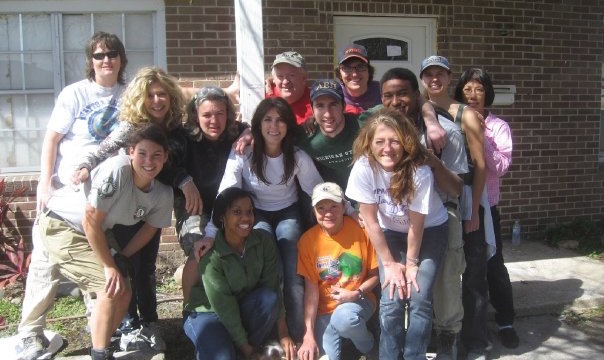
In the next few days, I will be uploading my pictures from the trip; there are many, and they have a lot of meaning for me. This whole trip has been extremely meaningful in ways with which I am still coming to grips. That’s why documenting it day-by-day was so important for me; I wanted to remember how I felt each day and how my emotions changed as I learned, did, and saw more.
I want to thank those of you who have read these notes over the past few days, and I especially want to thank those of you who have left such wonderful comments; I smiled every time I saw a new one, and I am glad I could provide a snapshot of an area I am dearly going to miss. Honestly, I think there is a real lack of awareness as to the area’s still-brutal condition; I know I didn’t realize the scope of it until I saw it first-hand. I encourage you to perhaps take a week of your own and do some volunteer work down here; it is an extremely gratifying experience, and the people of the area could definitely use it.
(Oh, and if you’re looking for a travel partner, I’m there …)
I look forward to returning to Buffalo tomorrow and seeing many of you again soon after. But I have been significantly moved by these six days in New Orleans, and I will never forget this trip that was truly unlike any other.
***
Several months after my week in New Orleans, volunteers at St. Bernard Project finished the renovation of Judy’s home. Several months after that, on August 29, Judy passed away. The first line of her obituary featured a final phrase both tragic and triumphant.
“Judy Lynn Moffett”, it said, had passed away from colon cancer … “in the comfort of her home.”
***
Matt Pearl is the author of the Telling the Story blog and podcast. Feel free to comment below or e-mail Matt at matt@tellingthestoryblog.com. You can also follow Matt on Facebook and Twitter.

